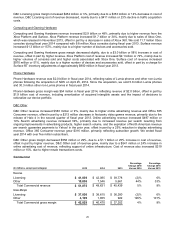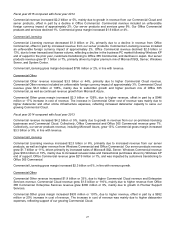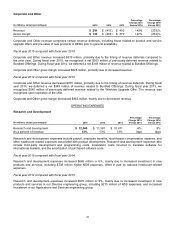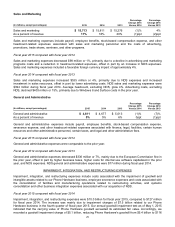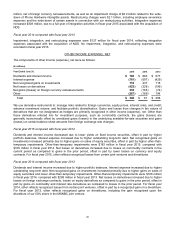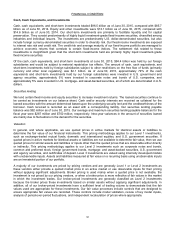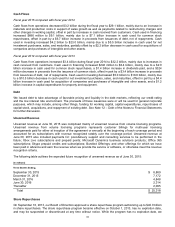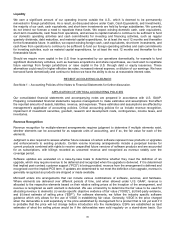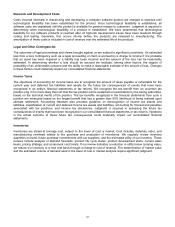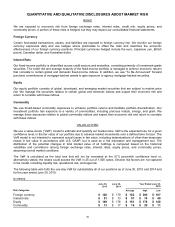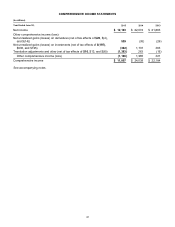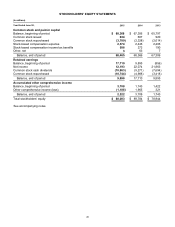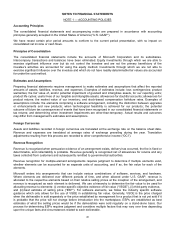Microsoft 2015 Annual Report Download - page 37
Download and view the complete annual report
Please find page 37 of the 2015 Microsoft annual report below. You can navigate through the pages in the report by either clicking on the pages listed below, or by using the keyword search tool below to find specific information within the annual report.36
process for determining ESPs requires judgment and considers multiple factors that may vary over time depending
upon the unique facts and circumstances related to each deliverable.
In January 2015, we announced Windows 10 will be free to all qualified existing users of Windows 7 and
Windows 8.1. This offer differs from historical offers preceding the launch of new versions of Windows as it is being
made available for free to existing users in addition to new customers after the offer announcement. We evaluated
the nature and accounting treatment of the Windows 10 offer and determined that it represents a marketing and
promotional activity, in part because the offer is being made available for free to existing users. As this is a marketing
and promotional activity, revenue recognition of new sales of Windows 8 will continue to be recognized as delivered.
Impairment of Investment Securities
We review investments quarterly for indicators of other-than-temporary impairment. This determination requires
significant judgment. In making this judgment, we employ a systematic methodology quarterly that considers
available quantitative and qualitative evidence in evaluating potential impairment of our investments. If the cost of an
investment exceeds its fair value, we evaluate, among other factors, general market conditions, credit quality of debt
instrument issuers, the duration and extent to which the fair value is less than cost, and for equity securities, our
intent and ability to hold, or plans to sell, the investment. For fixed-income securities, we also evaluate whether we
have plans to sell the security or it is more likely than not that we will be required to sell the security before recovery.
We also consider specific adverse conditions related to the financial health of and business outlook for the investee,
including industry and sector performance, changes in technology, and operational and financing cash flow factors.
Once a decline in fair value is determined to be other-than-temporary, an impairment charge is recorded to other
income (expense), net and a new cost basis in the investment is established. If market, industry, and/or investee
conditions deteriorate, we may incur future impairments.
Goodwill
We allocate goodwill to reporting units based on the reporting unit expected to benefit from the business
combination. We evaluate our reporting units on an annual basis and, if necessary, reassign goodwill using a relative
fair value allocation approach. Goodwill is tested for impairment at the reporting unit level (operating segment or one
level below an operating segment) on an annual basis (May 1 for us) and between annual tests if an event occurs or
circumstances change that would more likely than not reduce the fair value of a reporting unit below its carrying
value. These events or circumstances could include a significant change in the business climate, legal factors,
operating performance indicators, competition, or sale or disposition of a significant portion of a reporting unit.
Application of the goodwill impairment test requires judgment, including the identification of reporting units,
assignment of assets and liabilities to reporting units, assignment of goodwill to reporting units, and determination of
the fair value of each reporting unit. The fair value of each reporting unit is estimated primarily through the use of a
discounted cash flow methodology. This analysis requires significant judgments, including estimation of future cash
flows, which is dependent on internal forecasts, estimation of the long-term rate of growth for our business,
estimation of the useful life over which cash flows will occur, and determination of our weighted average cost of
capital.
The estimates used to calculate the fair value of a reporting unit change from year to year based on operating
results, market conditions, and other factors. Changes in these estimates and assumptions could materially affect the
determination of fair value and goodwill impairment for each reporting unit.
Based on the results of our annual goodwill impairment testing as of May 1, 2015, we determined that goodwill
associated with our Phone Hardware reporting unit was impaired, resulting in a material charge to earnings in the
fourth quarter of fiscal year 2015. As of June 30, 2015, none of our reporting units were considered to be at risk of
impairment.


